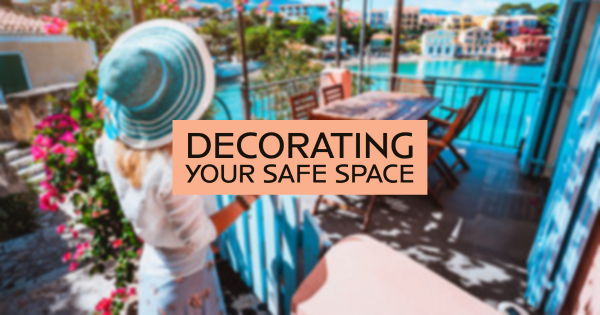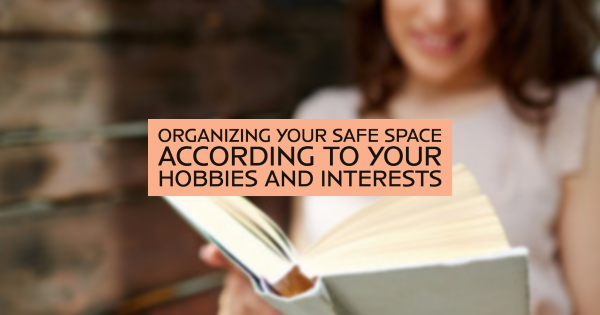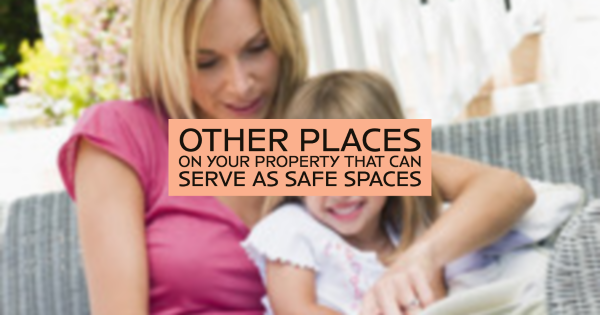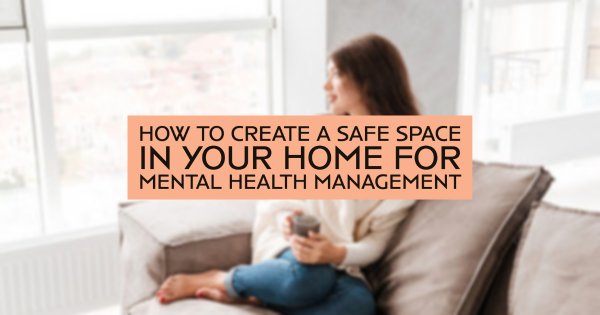
You’ve probably heard the term ‘safe space’ numerous times. But what is a safe space and why would you need to learn how to create a safe space for yourself? As it turns out, safe spaces can be safe in both the physical and emotional sense.
Anyone who’s ever been bullied understands the need for psychological safety. Imagine being a kid and walking into unfriendly territory, whether in the neighborhood or on the school playground. Wouldn’t you wish you knew how to create a safe space right away? Of course. The reason is that you’d be overwhelmed by worry and anxiety.
However, safe spaces aren’t just kids’ play. In fact, they’re seriously important for adults. That’s why it’s important for you not only to understand why you should learn how to create a safe space in your home but to take it upon yourself to carve out a safe area pronto. And it’s all because safe spaces are essential in managing mental health.
The Importance of Mental Health Management

It’s no secret that in the current uncertain economic, social, and health climate, people are feeling edgy to begin with. They aren’t feeling very safe, either. When every other headline talks about vaccines, cases, and hospitalizations, it’s tough for anyone to stay perfectly calm. That’s why mental health management is so urgently needed, including in the form of knowing how to create a safe space.
Of course, most of us aren’t just dealing with Covid. We’re bombarded by other psychologically troubling issues. Perhaps we’re in the middle of divorce mediation, battling a contentious ex-spouse for child support or custody. Maybe we’re facing the financial and emotional concerns related to the funeral of a loved one who hadn’t planned for the end of life expenses. Whatever our struggles, our mental health is bound to suffer.
What occurs when mental health begins to nosedive? A few things could potentially happen, although every individual reacts differently. Some kids and adults begin to get moody or withdrawn. They stop enjoying the things they used to do and participate less in everyday activities. Other folks lash out because they’re in hyper-protection mode. Still, others may simply focus only on one passion, such as school or work, and end up pushing away the outside world in favor of an insular place of their creation.
While any responses are understandable, the ones listed above aren’t good for long-term mental health management. That’s why understanding how to create a safe space can be so valuable. Of course, safe spaces can’t and shouldn’t come at the expense of working with a professional such as a counselor or therapist. Nevertheless, recognizing how to create a safe space can be a good step toward feeling less emotionally and maybe even physically depleted on a daily basis.
Below are a few ways you can carve out a safe space in your apartment or home. Even if it’s just a small area, it will provide a place of peace and tranquility.
Finding a Spot in Your Home
Whether your home is cozy or abundant, you first need to find a spot to call your own. This will be your safe place. But it may take a little imagination to figure out where you want it to be. And before you begin in earnest, make sure your family understands that your safe spot will be a place where you shouldn’t be disturbed. Otherwise, you won’t feel a sense of relaxation when you go to the safe zone.
Some places to consider making your safe space could include rooms that you rarely or barely use. For instance, a garage, attic, or basement could become a great safe spot. You may have to add some climate controls, such as buying a small portable heater or air conditioning unit. Those small additions will make it more comfortable and inviting. Otherwise, you won’t want to head to your safe space when you’re feeling blue, overwhelmed, or nervous.
Be aware that if necessary, you could always section off a safe space in a shared room with a temporary screen or, if you’re serious about keeping your safe space long-term, retrofitted sliding doors. Again, you may have to get creative depending upon the layout of your house, townhome, or apartment. Even a well-lit walk-in closet could become a location where you feel like you’re safe. The point isn’t to have a giant room. In fact, it’s to pick out a zone that’s all yours.
While you’re looking for the right spot in your quest to master how to create a safe space, you may want to encourage others in your household to do likewise. For instance, your spouse, partner, or kids might be interested in also setting up safe spaces. Or, you could share a safe space for all of you. Use your best judgment.
Decorating Your Safe Space

Once you’ve figured out the perfect place for your personalized safe space, you can start adding decor to it. A good item to start with is something you can sit on. This could be a traditional chair, a mat on the floor, or even a beanbag. If your safe space is a guest bedroom, the bed could become a comfy haven, or perhaps you’ll want to add a loveseat or oversized recliner to the room.
You don’t have to make your safe zone like a Pinterest image of a picture-perfect house. Still, it should be an area that makes you feel good. Don’t have any walls to hang those whimsical art prints in any other part of your house? Put them in your safe spot! Want to decorate with vibrantly colored window coverings? Go for it.
Why would you spend all the time and energy to deck out your safe space as though you were an interior designer extraordinaire? It’s all part of the psychological safety idea. By making your safe spot completely unique to your likes and dislikes, you’ll be more encouraged to go there when you need a break from the regular hubbub and whirlwind of life.
Organizing Your Safe Space According to Your Hobbies and Interests

As you’re focusing on decorating during your mission to learn how to create a safe space, be sure to keep the chaos to a minimum. Even if you claim to love clutter, you’ll want to keep your safe space as organized as possible. Therefore, if you’ve been knee-deep in figuring out how to plan a quinceanera during a pandemic, you probably don’t want to have lots of quinceanera reminders in your safe spot.
On the other hand, if you have something that makes you happy, like photos of you and your spouse when you were first adopting a child who became your grown son, by all means, keep them present. The goal should be to organize your safe space in a way that allows you to be able to find the things you love most and that keep you grounded and calm.
Don’t overlook the value of books for your safe space, either. Having a book to pick up and read can help calm frayed nerves when your anxiety is going through the roof. And if you’re into writing, having a journal and pen waiting in your safe spot could be exactly what you need to get your breathing, heart rate, and racing mind under control.
Try Not to Lean on Technology

One item we haven’t said anything about when discussing how to create a safe space is technology. That’s on purpose. Though technology can provide some relief, it can also be a source of mental strain. Even visiting social media sites can cause anxiety, especially if you start to get too trapped in a cycle of trying to earn social validation from followers in the form of comments and likes.
Think very long and hard about having any technical devices in your safe space, other than something to play music. Your safe space may be one of the only areas in your home where you don’t let your cell phone or laptop tag along. That’s perfectly okay, and your mental health may benefit from your diligence.
If you’re not sure you can live without having some technology by your side, at least make sure you temper your desires. Jot down your stress level before and after using technology in your safe zone. Do you notice that your stress goes up after jumping on your tablet? That’s a clear indication that you may be better off leaving it in another room.
Other Places On Your Property That Can Serve as Safe Spaces

At this point, you may feel a little like you’re out of luck because you can’t think of any interior room that could make a decent safe space. Is it possible, then, that your safe space could be outdoors? For instance, if you have a swimming pool, you might be able to create a hidden garden with trellis nearby so you can relax when the weather’s beautiful while still getting the undisturbed advantages of being in an emotionally safe zone.
A huge upside of choosing an outdoor safe space is that it may actually improve the perceived curb appeal of your home, or even your property’s actual resale value. Simple landscaping can improve the selling price of a residence by up to 14%. That’s quite a bit. So just by adding an extension to your patio or raising a gazebo, you could also give your home a financial boost if you ever sell it, refinance it, or take out a home equity line of credit loan. And that’s likely to help you lower your anxiety just knowing you’ve done something good for your house.
Want other suggestions in terms of outdoor places that make good safe spaces? How about a shed or even your children’s abandoned tree house? Perhaps a path that’s in a woodsy, tree-lined area right behind your home but still in your property? You could even put a little wooden swing or bench under your favorite oak tree. No, you won’t be able to escape to this safe space when the weather doesn’t cooperate. However, you’ll always have a location to head to when you’re troubled on a fairly nice day.
In fact, some people like to have both an indoor and outdoor safe space. This provides a bit of variety and allows you to switch up your de-stressing. Whatever will help you is worth trying as you embark on how to create a safe space for yourself.
Utilizing Mental Health Resources
As mentioned previously, it’s important that if you’re feeling depressed, angry, or agitated that you get in touch with a professional. You may want to first contact your family doctor to discuss other experts in the area who can help you work through your feelings. You don’t have to feel embarrassed or feel like a failure because you need assistance. Many people get help from counselors, psychiatrists, and psychologists. Your best friend, boss, or a next-door neighbor could be seeing a therapist without your ever knowing.
In addition to speaking with your physician, you may want to turn to technology for just a bit. Specifically, look up some of the many mental health resources, groups, associations, and referral sites online. No matter what you’re feeling, you can find relief and answers in a lot of virtual locations. Additionally, you may realize that you need help for associated problems like alcoholism, suicidal tendencies, gambling, smoking, or anger problems.
Remember: You shouldn’t have to face your mental health dilemmas and worries alone. Yes, you’re learning how to create a safe space. And that’s an essential element to better mental health management. However, safe spots are only part of the solution. Another part is getting professional help when and where you need it. Be aware that you may even be able to get some therapy or counseling at reduced rates or even free. Always talk with your healthcare insurance provider to see what’s possible.
It doesn’t take long to set up your safe space in your home. By this time tomorrow, you could have a special niche where you can go to unwind and get your head in a better place. You’ll never know the freedom and satisfaction of safe zones until you try one for yourself.
